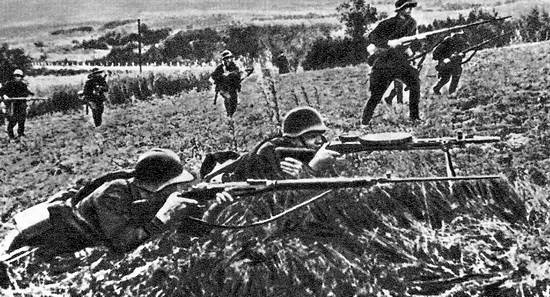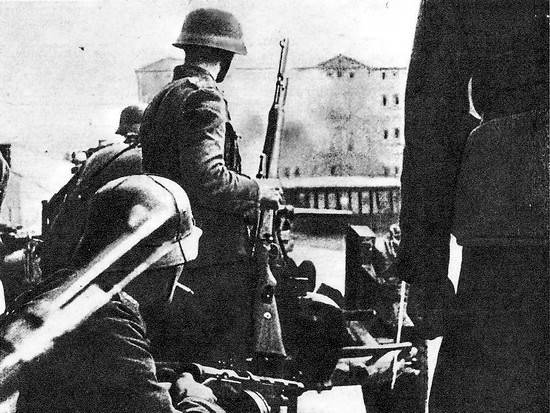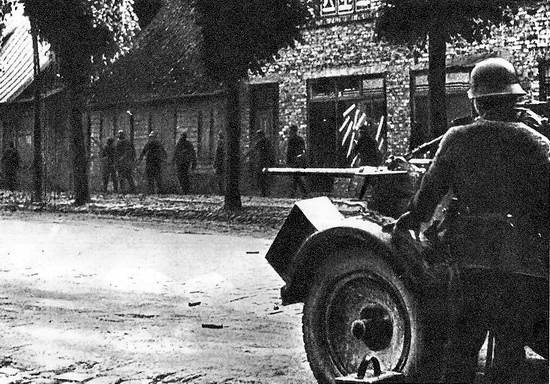Defense of Liepaja

Soldiers of the 67th Rifle Division in the exercise.
Liepaja (Libava), already in the Middle Ages famous for its trade port, which did not freeze even in the most severe winters, in the years preceding the war, became the third largest city in Latvia (population 57 thousand in 1935).
On the sea
In 1940, it became the forward base of the Baltic fleet THE USSR. Initially, a large naval force with a cruiser, destroyers and submarines was concentrated in a small port, and a large amount of military materials were in warehouses.
However, as the threat from Nazi Germany grew, the Soviet command realized the vulnerability of the port, which was brought almost to the border with Germany. Liepaja is located about 90 km from Klaipeda (Memel). And thus, the forces located there, in the event of a surprise attack, were exposed to the blows of the German aviation, fleet and ground forces.
The defense of the base was being prepared from the very moment of the annexation of Latvia to the USSR. But it was too short a time for the restoration of the neglected military port and the construction of a system of permanent fortifications, first of all, permanent coastal artillery batteries of large caliber.
Nevertheless, from the side of the sea, the defense of Liepaja was quite strong. Taking into account the fact that surface and submarine ships of the Baltic Fleet were supposed to participate in it, two coastal batteries of 130 mm guns and four batteries of smaller caliber guns, two batteries of railway guns and the 43rd separate aviation squadron of the Baltic Fleet Air Force, which was armed with 40 flying boats MBR-2.
The defense plan also provided for the setting of minefields on the approaches to the base. For air defense, a fighter aviation regiment was located near the city, and in the base itself - 6 batteries of anti-aircraft guns.
And about. The base commander, Captain First Rank Mikhail Klevensky, had a separate infantry battalion, machine-gun company, railroad and fire-fighting company. In case of war, the cadets of the naval air defense school located in Liepaja obeyed him. On the land side, the basis of Liepaja's defense was to be made up of the units of the 67th Infantry Division from the 8th Army.
However, the task of the division under the command of Major General Nikolai Dedaev was to defend not only Liepaja, but also a large, almost 200-kilometer stretch of coast, along which its parts were scattered. However, in the pre-war years, the land defense of Liepaja was not given much importance due to the ingrained idea of the power of the Soviet armed forces, which would not allow such a deep penetration of enemy troops into the territory of the Soviet Union. Accordingly, there was not even a thought about the need to organize a strong defense and the one-man command of its command.
The base commander was directly subordinate to the command of the Red Banner Baltic Fleet, and the commander of the 67th division - to the command of the 8th Army and the front command. In practice, commanders at all levels of the military hierarchy worked closely with each other. But nevertheless, the division of responsibility in wartime did not contribute to the concentration of all forces and means to achieve the primary goals in a specific combat situation. The base commander and division commander received orders from their superiors and carried them out independently. Although in many cases, with a single command, the same goals could be achieved with fewer forces and means.
The attack of Hitler's Germany on the Soviet Union for the defenders of Liepaja did not become sudden, thanks to the measures taken earlier to increase combat readiness. The first German air strikes on the morning of June 22 found the defenders of the base at firing positions. Under anti-aircraft fire from batteries and ships, the planes were unable to drop bombs aimingly. And the destruction was insignificant.
Soon after the first air raid, four submarines left the base - M-79, M-81, M-83 и A-3 - with the task to take positions on the approaches to Liepaja. At the same time a minesweeper "Fugas" began laying a minefield 10 miles from Liepaja. In total, this ship delivered 206 mines over several exits to the sea.

Hitler's soldiers during the fighting at the bridge over the canal.
On the land
The situation on land was much worse.
At the start of the war, the 67th division had not yet had time to bring itself into full combat readiness. Meanwhile, the 291st Infantry Division of Lieutenant General Kurt Herzog from the 18th Army of Colonel General Georg von Kühler began its offensive on the Memel - Liepaja direction.
Having crossed the state border of the USSR, the division broke through the defenses of the border troops and, without significant resistance, moved in the direction of Liepaja. In the afternoon of June 22, German units reached the Barta River, which flows 17 km south of Liepaja. There they were stopped by units of the 67th division, but not for long. Since after an unsuccessful attempt to force the river on the move in the area north of Nitsa, the Germans regrouped further east, where they crossed the river without encountering resistance. At this time, 6 submarines and 8 ships left the port of Liepaja and headed to Ventspils and Ust-Dvinsk.
Meanwhile, soldiers, sailors and civilians hastily set up defensive lines around Liepaja, primarily by digging trenches and preparing machine-gun points. To strengthen the land defense, Captain Klevensky allocated all free units of sailors to the 67th division, including the crews of the ships being repaired. Also, coastal and anti-aircraft batteries were deployed to provide fire support for ground units. And they came under the command of the 67th division.
The defense was strengthened by detachments of volunteers from among the civilian population that arrived at the disposal of the 67th Division. So already on the first day of the war, all Soviet forces in the Liepaja area were practically under the command of General Dedaev, although this was not provided for by defense plans, but turned out by itself in the current situation.

The Nazis on the streets of Liepaja.
By the evening of the first day of the war, German troops managed to cut off the railway connection between Liepaja and Riga. And then they attempted to take the city by attack from the east. The attack was repulsed in a fleeting battle, in which the coastal batteries supported the Soviet troops with their fire.
Over the next two days, the Germans, with the support of aviation, repeatedly tried to break into the city, but all their attacks were repulsed. Nevertheless, the situation worsened with each passing hour. Coastal batteries were not always able to support the forward detachments with their fire, since their positions were not prepared for firing at targets on land, and they themselves were under attack from the air.
Soviet aviation suffered huge losses on the first day of the war, and the surviving aircraft were forced to leave the destroyed airfield near Liepaja and relocate closer to Riga. Also, flying boats of the 43rd squadron were relocated to Riga, since their base on Lake Durbes was within the reach of enemy fire.
Even worse, on June 24, German troops bypassed Liepaja from the north and completely surrounded it from land. The defenders of the base were cut off from the 8th army, which could not come to their aid, as it itself was rolling back under the onslaught of the enemy to Riga. The situation at sea also worsened, as German submarines began to mine the approaches to the base, and two of them began to hunt for Soviet ships. From 10 to 12 torpedo boats of the 3rd flotilla appeared in the Liepaja area.
The critical moment in the defense of Liepaja came on June 25, when the Germans pulled heavy artillery to the city, and under its fire they managed to cut through the ledges in the Soviet defense. There was a threat of seizure of the naval base and the shipyard. The defenders began to undermine depots with mines, ammunition and fuel in order to prevent them from falling into the hands of the enemy. At the same time, the destroyer was blown up. "Lenin".
It is generally accepted that the decision was made by the commander "Lenin", Lieutenant-Commander Yuri Afanasyev. But the fact that together with Lenin the submarines were blown up M-71, M-76, C-1, "Ronis" и "Spidola", who did not obey Afanasyev in any way, indicates that the order for the self-flooding of the ships could have come from Captain Klevensky.
The equipment and mechanisms of the shipyard were also undermined. By that time, all patrol boats left Liepaja, the minesweeper "Fugas" and the sub C-3... Only 5 torpedo boats and 10 transport ships remained in the base.
Worse fate was with the submarine C-3... Under the command of Lieutenant Commander Nikolai Kostromichev, she went to sea alone, although the ship was damaged and unable to dive. Meanwhile, at sea, abeam the Uzhava lighthouse, German torpedo boats were patrolling. An unequal battle ensued. An hour and a half C-3 repelled the attacks of a superior enemy with the fire of two guns of caliber 100 and 45 mm. She even managed to dodge several torpedoes with skillful maneuvers, but two of them still hit the target. The explosions tore the submarine's hull in three parts. Who knows, maybe the tragedy could have been avoided if C-3 went to sea, accompanied by patrol boats.
Assault
The next day, June 26, the Germans began to storm the city.
With the support of artillery, tanks and planes they managed to break into the streets of Liepaja. Bloody street fighting continued throughout the day. The commander of the 67th division, Dedaev, was killed in the battles. And although the Germans failed to take neither the city nor the base, the position of the defenders was already hopeless.
Therefore, on the evening of June 26, it was decided to break out of the encirclement with the remnants of forces. The task was not easy. All roads were already cut, and the waterways were not suitable for the evacuation of personnel and property due to lack of time and vehicles.
On the night of June 26-27, the last remaining ships, boats and other floating craft, overcrowded with evacuees, left the port. The boats were the last to leave the base CT-17 и CT-47 with the headquarters of the base. On the high seas, they were attacked by 6 torpedo boats.
Died in an unequal battle CT-17. But CT-47 managed to pick up the survivors and get to the Gulf of Riga. Some detachments of soldiers, sailors and militias were forced to stay in Liepaja to cover the breakthrough. Some of them managed to withstand the continuous onslaught of the enemy, break out of the encirclement and join forces with the 8th Army or start a partisan struggle in the forests of Latvia. Scattered groups continued to resist for another five days in different parts of the city.
Liepaja became the first Soviet naval base captured by Nazi troops.
Her defense left much to be desired. But in the current situation, it was carried out competently and with great dedication by soldiers, sailors and militias. The base turned out to be, in principle, not prepared for defense from the land side. And it was from this direction that the blow came already on the first day of the war.
Nevertheless, on the line of hastily dug trenches, the defenders managed to hold out for five days in battles with a superior enemy, and then evacuate part of the forces by sea. Moreover, until July 1, they managed to prevent the advance of an entire German division in small groups.
Despite the fact that the Liepaja legend remains, as it were, in the shadow of the epic of the Brest Fortress, historians Alexei Isaev and Sergei Buldygin consider it an underestimated local success of the Red Army.
In any case, the defense of Liepaja was not in vain. And her experience was later useful in the defense of other naval bases.
Sources and literature:
N.K. Kuznetsov. In the fleets, combat alert... Military Publishing, 1971.
V.I.Savchenko. Seven fiery days of Liepaja... Zinatne, 1985.
A.V. Isaev. Another 1941. From the border to Leningrad... Eksmo, Yauza, 2011.
A.V. Isaev. Border battle 1941. First battle of the Great Patriotic War... Yauza, 2020.
S. B. Buldygin. Defense of Liepaja... Gangut, 2012.
Продолжение следует ...
Information